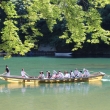
Shimogamo-Jinjya Shrine
- 梅の名所
- 紅葉の名所
- 世界遺産
- ★ ミシュラングリーンガイド 一ツ星
HISTORY
It is the oldest group among the temple and shrine in Kyoto, and is reported in the historical record that there was the tradition of deities at the era of Emperor Jinmu. Even though there are various stories regarding the time when its shrine pavilions was founded, you may see the record that it was reconstructed several times before Nara period. The imperial place had been placed over 400 years after 810 (the first year of Kounin era), the imperial princess rendered a service to Kamo shrine as a Kamo-Saiou.
In addition, it was prospered as a central of region and culture at that time as it was come up often in the dynastic culture such as “Genji Story” or “Makurano-soushi”.
At the period of Heian period, 60 lords having the manor or the place offering the to the god were prospered, through Kamakura period, Muromachi period and other war-tore era, such manor went in a decline. It was the time when the Sindenmori went around the country and you may see the situation at that time through the no-play (traditional masked dancing dram). At the beginning of Meiji period, it was listed at the top ranking of Shrine categories in Japan.
translation:MAKOTO
WORLD’S CULTURE HERITAGE
The shrine pavilions was registered as the world’s culture heritage in 1994 (the sixth years of Heisei era) as it has the two pavilions (National Treasures) of inner shrine and 53 ridges (Important Cultural Property)
translation:MAKOTO
AOI FESTIVAL/THREE BIGGEAST FESTIVAL IN KYOTO
On May 15, every year, Aoi Festival is so famous for playing the scene of a Japanese narrative scroll and at the time when the parade arrive at the Shrine, the shato no gi is held at the stage. The Kamo festival (Aoi festival) started in 544 (the fifth year of Kinmei era), at that time speking of the festival, it was recognized as the Aoi festival, so it was famous and prosperous. After transaction of old metropolitan “Heian-Kyo”, it was served as the special faith as the guarded god of imperial house. In 807 (the second year of Daido era), it was registered as the Tyokusai (the festival to where the emperor send the messenger) with having the top ranking of shrine.
translation:MAKOTO
Michelin Green Guide
Shimogamo Shrine have an one star rating
translation:MAKOTO
- Other Names
- Kamo-Goso Jinjya
- Address
- 59, Shimogamo Iszumi chou, Sakyou-ku, Kyoto-City, 606-8407
- TEL
- +81-75-781-0010
- FAX
- +81-75-781-4722
- Formal Name
- Kamo-Goso Shrine
- Date Founded
- Unknown, the 90th century BC
- Cultural Properties
Kamo-Goso Shrine, east main hall, west main hall (National Treasures, Important Cultural Property), Kmo-Goso shrine, Shinto prayers, Hall for prayer, east-west corridor (Important Cultural Property),
The close of Kamo-Goso Shirein (Historical Site)- Deities
- Tamayorihimeno-Mikoto Kamotaketsununo-Mikoto
- Annual Festival
- May 15 (Kamo Festival, Aoi Festival)
- Benefit
Road Safety, Travel Safety (Shimogamo Shrine), Marriage Tie (Aoi Shinto Shreine), Avoidance of Accident (Inoue Shinto Shrine, Mitarai Shinto Shrine)
- Hours
6:00~17:00 (changeable depending on the season)
- Parking
Available
- Access Guide
Get off at Demachi-Yanagi Station of Keihan Line and 12 minutes walk
Get off at Shimogamo Jinjya Station of Municipal Buss and 5 minutes walk- Official Website
- https://www.shimogamo-jinja.or.jp/
※このページの内容は掲載時点での情報です。変更となる可能性がありますので、お出掛けの際は事前にご確認ください。




























